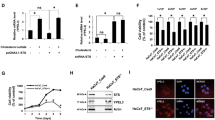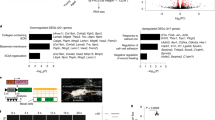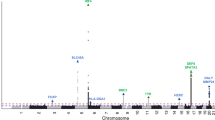Abstract
R-spondins are a recently characterized small family of growth factors. Here we show that human R-spondin1 (RSPO1) is the gene disrupted in a recessive syndrome characterized by XX sex reversal, palmoplantar hyperkeratosis and predisposition to squamous cell carcinoma of the skin. Our data show, for the first time, that disruption of a single gene can lead to complete female-to-male sex reversal in the absence of the testis-determining gene, SRY.
This is a preview of subscription content, access via your institution
Access options
Subscribe to this journal
Receive 12 print issues and online access
$209.00 per year
only $17.42 per issue
Buy this article
- Purchase on Springer Link
- Instant access to full article PDF
Prices may be subject to local taxes which are calculated during checkout





Similar content being viewed by others
Accession codes
References
Brennan, J. & Capel, B. One tissue, two fates: molecular genetic events that underlie testis versus ovary development. Nat. Rev. Genet. 5, 509–521 (2004).
Ross, A.J. & Capel, B. Signaling at the crossroads of gonad development. Trends Endocrinol. Metab. 16, 19–25 (2005).
Yao, H.H. The pathway to femaleness: current knowledge on embryonic development of the ovary. Mol. Cell. Endocrinol. 230, 87–93 (2005).
Wilhelm, D. & Koopman, P. The makings of maleness: towards an integrated view of male sexual development. Nat. Rev. Genet. 7, 620–631 (2006).
Koopman, P., Gubbay, J., Vivian, N., Goodfellow, P. & Lovell-Badge, R. Male development of chromosomally female mice transgenic for Sry. Nature 351, 117–121 (1991).
Bishop, C.E. et al. A transgenic insertion upstream of sox9 is associated with dominant XX sex reversal in the mouse. Nat. Genet. 26, 490–494 (2000).
Vidal, V.P., Chaboissier, M.C., de Rooij, D.G. & Schedl, A. Sox9 induces testis development in XX transgenic mice. Nat. Genet. 28, 216–217 (2001).
Qin, Y. et al. Long-range activation of Sox9 in Odd Sex (Ods) mice. Hum. Mol. Genet. 13, 1213–1218 (2004).
Radi, O. et al. XX sex reversal, palmoplantar keratoderma, and predisposition to squamous cell carcinoma: genetic analysis in one family. Am. J. Med. Genet. 138, 241–246 (2005).
Micali, G. et al. Association of palmoplantar keratoderma, cutaneous squamous cell carcinoma,dental anomalies, and hypogenitalism in four siblings with 46,XX karyotype: a new syndrome. J. Am. Acad. Dermatol. 53, S234–S239 (2005).
Vernole, P. et al. An SRY-negative XX male with Huriez syndrome. Clin. Genet. 57, 61–66 (2000).
Riggio, E., Spano, A., Bonomi, S. & Nava, M. Huriez syndrome: association with squamous cell carcinioma and a surgical approach. Plast. Reconstr. Surg. 116, 689–691 (2005).
Kim, K.A. et al. R-Spondin proteins: a novel link to beta-catenin activation. Cell Cycle 5, 23–26 (2006).
Kazanskaya, O. et al. R-Spondin2 is a secreted activator of Wnt/beta-catenin signaling and is required for Xenopus myogenesis. Dev. Cell 7, 525–534 (2004).
Kamata, T. et al. R spondin, a novel gene with thrombospondin type 1 domain, was expressed in the dorsal neural tube and affected in Wnts mutants. Biochim. Biophys. Acta 1676, 51–62 (2004).
Christiano, A.M. Frontiers in keratodermas: pushing the envelope. Trends Genet. 13, 227–233 (1997).
Guerra, L. et al. Erbium:YAG laser and cultured epidermis in the surgical therapy of stable vitiligo. Arch. Dermatol. 139, 1303–1310 (2003).
Kim, K.A. et al. Mitogenic influence of human R-spondin1 on the intestinal epithelium. Science 309, 1256–1259 (2005).
Nam, J.S., Turcotte, T.J., Smith, P.F., Choi, S. & Yoon, J.K. Mouse cristin/R-spondin family proteins are novel ligands for the Frizzled 8 and LRP6 receptors and activate beta-catenin-dependent gene expression. J. Biol. Chem. 281, 13247–13257 (2006).
Kim, Y. et al. Fgf9 and Wnt4 act as antagonistic signals to regulate mammalian sex determination. PLoS Biol. 4, e187 (2006).
Akiyama, H. et al. Interactions between Sox9 and beta-catenin control chondrocyte differentiation. Genes Dev. 18, 1072–1087 (2004).
Ott, J. Analysis of Human Genetic Linkage (Johns Hopkins Univ. Press, Baltimore, 1992).
Terwilliger, J.D. & Ott, J. Handbook of Human Genetic Linkage (Johns Hopkins Univ. Press, Baltimore, 1994).
Bernerd, F. et al. Clues to epidermal cancer proneness revealed by reconstruction of DNA repair-deficient xeroderma pigmentosum skin in vitro. Proc. Natl. Acad. Sci. USA 98, 7817–7822 (2001).
Hogan, B., Beddington, R., Costantini, F & Lucy, E. Manipulating the Mouse Embryo 2nd edn. (Cold Spring Harbor Laboratory Press, Cold Spring Harbor, New York, 1996).
Wilkinson, D.G. Whole-mount in situ hybridization of vertebrate embryos. in In Situ Hybridization: a Practical Approach (Oxford Univ. Press, Oxford 1992).
Acknowledgements
We are indebted to patients and clinicians for active collaboration in the research and with S. Bondanza and S. Pezzaia for technical help. We also thank M. Magliano for help in the in situ experiments. This work was supported by grants from Coperativa Est Ticino, Telethon, the European Community, the Ministero Italiano dell'Università e della Ricerca and the Consiglio Nazionale Delle Ricerche.
Author information
Authors and Affiliations
Corresponding author
Ethics declarations
Competing interests
The authors declare no competing financial interests.
Supplementary information
Supplementary Fig. 1
Haplotype analysis in patients and genome-wide SNP analysis. (PDF 21 kb)
Supplementary Fig. 2
Hypothetical RSPO1 proteins produced in patients. (PDF 40 kb)
Supplementary Fig. 3
Real-time PCR analysis on staged embryos. (PDF 90 kb)
Supplementary Table 1
Oligonucleotide sequences. (PDF 10 kb)
Rights and permissions
About this article
Cite this article
Parma, P., Radi, O., Vidal, V. et al. R-spondin1 is essential in sex determination, skin differentiation and malignancy. Nat Genet 38, 1304–1309 (2006). https://doi.org/10.1038/ng1907
Received:
Accepted:
Published:
Issue Date:
DOI: https://doi.org/10.1038/ng1907
This article is cited by
-
R-spondin-1 induces Axin degradation via the LRP6-CK1ε axis
Cell Communication and Signaling (2024)
-
Rspo2 exacerbates rheumatoid arthritis by targeting aggressive phenotype of fibroblast-like synoviocytes and disrupting chondrocyte homeostasis via Wnt/β-catenin pathway
Arthritis Research & Therapy (2023)
-
PRC1 suppresses a female gene regulatory network to ensure testicular differentiation
Cell Death & Disease (2023)
-
Genetic control of typical and atypical sex development
Nature Reviews Urology (2023)
-
Identification of an SRY-negative 46,XX infertility male with a heterozygous deletion downstream of SOX3 gene
Molecular Cytogenetics (2022)



